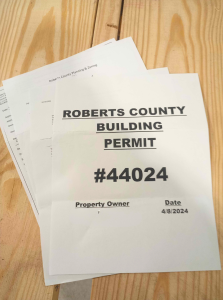Do the poles start to rot out after so many years? That depends on whether or not they are pressure treated.
This question was recently posed to me by reader MARK in WOLCOTT. Typically my answer would include some snarky comment such as: “Most certainly, however it might not be during your grandchildren’s grandchildren’s lives!”
The reality is, I know lots and lots of people in the lumber and post frame building industry. Having spent my entire adult life in it tends to add to these. I have yet to meet anyone, who can tell me they have actually experienced a properly pressure preservative treated wood building column rot.
Of course there are always those who have stories such as, “My Uncle’s cousin says he knows of somebody, who knew somebody who had all of their pole barn poles rot off”. Could be – and they probably were not pressure preservative treated at all!
In order to put this matter to rest and ease my already untroubled mind, I utilized the power of the internet and Google to do some research.
Well, it turns out four fine people named Stan Lebow, Bessie Woodward, Grant Kirker and Patricia Lebow got their collective thinking caps together and wrote an article entitled “Long-Term Durability of Pressure-Treated Wood in a Severe Test Site”. Said article was published in Advances in Civil Engineering Materials, Vol. 2 No. 1, 2013 on pages 178-188 (for those of you who want to read it in its full and unabridged glory: https://www.fpl.fs.fed.us/documnts/pdf2013/fpl_2013_lebow001.pdf).
Our team of authors was motivated, as stated in the introduction to the article, by this:
“Pressure-treated wood has been widely used as a durable construction material in the United States for over a century. However, despite its long history of use, there are relatively few reports on the long-term decay and insect resistance of pressure-treated wood”.
 Now, as it so happens, the USDAFS (U.S. Department of Agriculture Forest Service) has a test site located near Saucier, Mississippi. The plot has a relatively high annual rainfall and warm temperatures which create a harsh decay environment. Eastern subterranean termites are active at the site. The location is within American Wood Protection Association (AWPA) Deterioration Zone 5, Severe Hazard, which is the most severe hazard classification.
Now, as it so happens, the USDAFS (U.S. Department of Agriculture Forest Service) has a test site located near Saucier, Mississippi. The plot has a relatively high annual rainfall and warm temperatures which create a harsh decay environment. Eastern subterranean termites are active at the site. The location is within American Wood Protection Association (AWPA) Deterioration Zone 5, Severe Hazard, which is the most severe hazard classification.
As a control, some untreated posts were placed and all failed in less than three years!
The current Code standard for pressure-preservative treated lumber for structural use is UC-4B (read one of my better articles of all time regarding pressure-preservative treating here: https://www.hansenpolebuildings.com/2012/10/pressure-treated-posts-2/). UC-4B requires a chemical retention for many water borne treatments such as ACZA, CCA-B and CCA-C of 0.60 lb/ft^3 (pounds of chemical per cubic foot of lumber). With retention levels LESS than the current UC-4B requirement, there have been ZERO failures in these chemicals in tests of up to 61 years!
I will stand upon my initial remarks for lifespan.










Guru, sorry, I just sent you this exact question (right before I found this post) I guess I don’t have to worry about the post rot thing. My building was a pre engineered kit and it has pressure treated posts! Thanks for the Information
When I go to my local building supply, can I rest assured what they have is treated to UC-4B specs or are there other levels of treatment? we have a second story deck on our house and some of the treated 2×6 deck boards have rotted and been replaced twice in 10 years.
Hello Ron,
Unfortunately you can not. The good news is each stick of lumber or post will show the treatment level on a sticker or stamp on the member. Sadly most building supply places do not stock posts treated to a UC-4B level. They are a specialty treatment that has to be specifically ordered. When we order lumber this can add weeks to get into a location because of the treatment but it is worth the wait. Just look for the treatment sticker which should state its treatment level along with its approved use.
I’ve used ground contact CCA treated 4×4 posts in Houston, TX for fences. They will last a maximum of 15 years before they are history. I can’t imagine the new formulations are any better. I’ve seen all the studies too. The problem is that I have first hand knowledge that the studies are BS. This isn’t one isolated case either. I’ve had this same outcome with 100’s of posts. It’s not a matter of if this will happen. It will, 100% of the time in Houston, guaranteed.
Hello John,
Thanks for sharing your experience. We have seen in many instances where a builder will use, or lumber yard will sell, “ground contact” treated posts for “in ground” use, or worse yet, the use of “green treated” wood. Ground contact is only approved for use wherein the name suggests, contact with the ground, and not “in” the ground. Used in this instance those would rot. Properly treated UC-4B “in ground’ posts have been lab tested in salt water environments with highly corrosive tendencies and has positive outcomes. A person could upgrade to UC-4C for a higher level of protection.
Here is NFBA https://www.nfba.org/index.php/design/foundations/treated-wood
Some studies have shown untreated to last only 4-5 years and Treated to UC-4B lasting 55-60 years.
Thank you
Hello, Big fan here! I have a shop with the Green Pressure Treated Posts in the ground in Oregon, and it can very soggy here. The shop’s 3o+ yrs old. I’ve often worried about it’s integrity and whether we should think about cutting and mounting them on a bracket in concrete footings someday. There are no stickers or numbers on the posts to identify them, they’re just green with pressure treated marks and dent patterns.. . Is there a way to test or confirm whether they’re UC-4B lumber of not? KInd Regards, Dave
From the era in which your building was erected, I would suspect they are .60 treated CCA (which would be today’s UC-4B). It is unlikely they will experience decay within your lifetime.